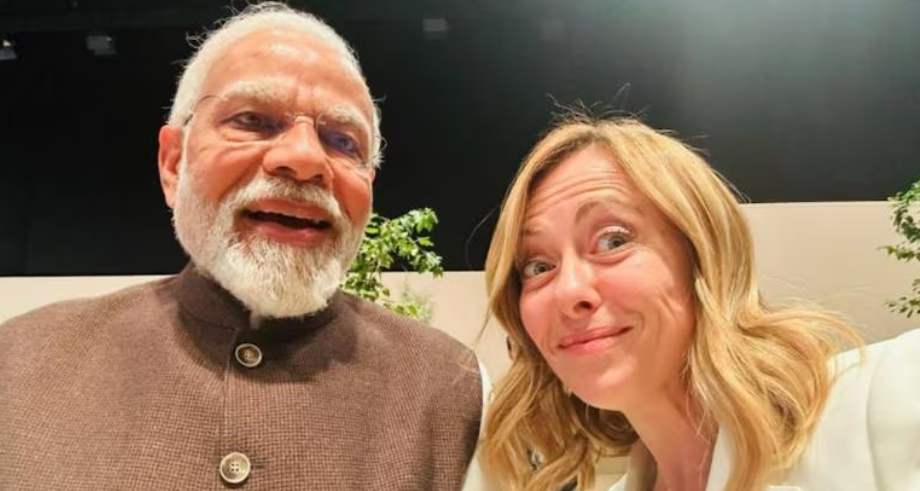Narendra Modi: Architect of India’s Political Landscape Image credit: @GiorgiaMeloni/X
Image credit: @GiorgiaMeloni/X
One name has come to represent leadership, vibrancy, and revolutionary government in the complex web of Indian politics: Narendra Modi. Since May 2014, Modi has held the position of India’s 14th and current prime minister. His ascent from a lowly upbringing to the pinnacles of authority is truly amazing. We examine the many dimensions of Narendra Modi’s leadership, his policy proposals, and his influence on the political climate in India in this blog article.
Early Life and Political Beginnings
Born on September 17, 1950, in Vadnagar, a small town in Gujarat, Narendra Damodardas Modi grew up in modest circumstances. His early years were marked by an unwavering spirit of service and a deep connection to his roots. Modi’s entry into politics occurred during his association with the Rashtriya Swayamsevak Sangh (RSS), a right-wing Hindu nationalist paramilitary volunteer organization. His grassroots work within the organization laid the foundation for his future political endeavors.
Chief Minister of Gujarat: The Development Mantra
The year 2001 marked a pivotal moment in Modi’s political career when he became the Chief Minister of Gujarat. Throughout his term, he prioritized infrastructure expansion, investment attraction, and economic development. Significant progress was made in the state in areas including industry, education, and agriculture. Though his development-focused government model won him praise, Modi’s administration came under fire during the 2002 Gujarat riots, which are still hotly contested today.
The 2014 Electoral Mandate: Prime Ministerial Journey Begins
In the 2014 general elections, Narendra Modi guided the Bharatiya Janata Party (BJP) to an unprecedented triumph. His campaign was built around the themes of good governance, economic progress, and a dedication to uplifting the underprivileged. The overwhelming mandate was a reflection of a country in need of a visionary and bold leader. With his appointment as prime minister, Modi’s style of leadership became known for its efficiency, results-driven governance, and hands-on attitude.
Swachh Bharat Abhiyan: A Clean India Mission
One of Modi’s flagship initiatives that garnered international attention is the Swachh Bharat Abhiyan, launched in 2014. Aimed at achieving a clean and open-defecation-free India, the campaign focused on sanitation and hygiene. The Swachh Bharat mission witnessed widespread public participation, with individuals, celebrities, and corporate entities actively contributing to the cause. While the initiative achieved significant success, challenges in sustaining cleanliness efforts persist, highlighting the ongoing nature of the mission.
Demonetization: A Bold Move
In a move that took the nation by surprise, Modi announced demonetization in November 2016, invalidating high-denomination currency notes to curb black money, corruption, and counterfeit currency. The decision, while applauded for its intent to tackle illicit financial practices, also faced criticism for its impact on the informal economy and the common man. Demonetization remains a subject of intense debate, with opinions divided on its long-term implications.
Goods and Services Tax (GST): A Paradigm Shift in Taxation
In July 2017, Modi oversaw the introduction of the Goods and Services Tax (GST), another important economic change. The GST replaced a convoluted network of indirect taxes with the goal of establishing a single tax system. Although the change was intended to simplify taxes and increase economic efficiency, there were teething problems with its implementation, and companies eventually adjusted to the new structure. In India’s economic landscape, the Goods and Services Tax (GST) is still a crucial reform that makes doing business easier.
National Security and Foreign Policy
Narendra Modi’s leadership has been tested on the national security front, particularly in the aftermath of terrorist incidents and border tensions. The 2016 surgical strikes conducted in response to a terrorist attack garnered widespread support, projecting a strong stance on national security. Modi’s foreign policy has seen efforts to strengthen bilateral ties, engage in regional diplomacy, and position India as a key player on the global stage. His proactive engagement with international leaders reflects a strategic approach to diplomatic relations.
Digital India: Empowering the Nation Technologically
The Digital India initiative, launched in 2015, seeks to transform India into a digitally empowered society and knowledge economy. The campaign envisions comprehensive digitization, from e-governance to digital literacy, and aims to bridge the urban-rural divide in access to technology. The push for a digital ecosystem aligns with the broader narrative of modernization and technological advancement.
Criticisms and Challenges
No political journey is without its share of criticisms and challenges, and Narendra Modi’s tenure is no exception. While his leadership has been praised for decisive governance, economic reforms, and a proactive foreign policy, critics have raised concerns about issues such as freedom of expression, minority rights, and economic inequalities. The complexities of governing a diverse and populous nation like India inevitably give rise to a spectrum of opinions and perspectives.
The 2019 Mandate: Renewed Confidence
In 2019, Narendra Modi secured a renewed mandate, leading the BJP to another decisive victory in the general elections. The electoral triumph reinforced his popularity and reflected the electorate’s endorsement of his leadership style and policy initiatives. The BJP’s success in multiple states further solidified Modi’s standing as a dominant political force.
Conclusion: A Dynamic Leadership Legacy
As we reflect on Narendra Modi’s leadership journey, it is clear that his tenure as Prime Minister has left an indelible mark on India’s political landscape. From economic reforms to social initiatives, his policies have aimed at addressing the diverse needs of a rapidly evolving nation. The nuances of his leadership style, the impact of his decisions, and the evolving narrative of governance under his stewardship continue to shape the discourse around India’s political trajectory.
Whether celebrated for his developmental initiatives or critiqued for policy decisions, Narendra Modi’s leadership is a dynamic force that navigates the complexities of India’s socio-political fabric. As the nation progresses into the future, the legacy of Modi’s leadership will undoubtedly be a subject of continued analysis, discussion, and reflection.
